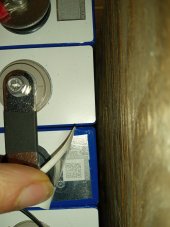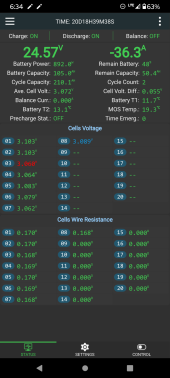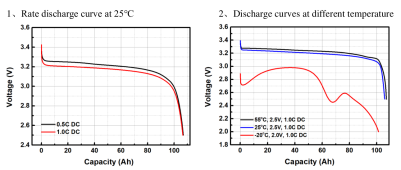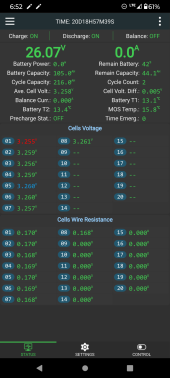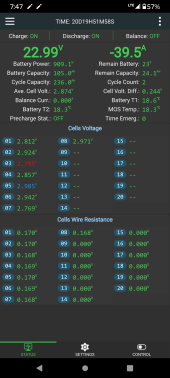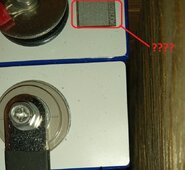sprucegum
New Member
First off, I'm off grid, so I don't have the ability to easily charge batteries besides through solar and doing a full discharge is risky because it leaves me without power if I get the weather predictions wrong.
I bought 8 LF105s from ezealco (here), hooked them up to a JK BMS, set conservative numbers on a Victron MPPT and have been using them for about 2 weeks. They arrived all at exactly 3.291 volts, had perfect QR codes and untouched packaging and appear to definitely be brand new cells. I didn't top balance because the volts were identical and the JK BMS has active balancing. Even at a peak of 3.45 it hasn't been more than 0.033v delta between them. So while maybe they need more balancing, they can't be far enough off to effect total capacity in a significant way.
Up until a few days ago, the lowest I had drained them according to my shunt was down by 20 or 25Ah from fully charged. I've had at least 2-3 times where they got all the way up to 3.45v (my absorb setting, which I hold for 30m for balancing) and I reset my shunts based on that. Because I'm off grid, with a single battery, doing a capacity test is hard to schedule -- especially in the winter (I'd have to do it in the morning right before the sun came up, get it finished before peak solar, and then be able to reclaim enough storage to get through the evening and possibly the next day depending on the weather).
In any event, in the last couple days we had limited enough sun that I was finally effectively capacity testing them (albeit it at low C rate). This evening, the battery was suddenly and unexpectedly down to 24v (my LVD). My shunt indicates about 65ah used; JK BMS says about 55ah (BMS seems to be off calibration because it consistently reads about .03v lower than the SCC, the shunt, or my voltmeter).
In either event I should be nowhere near 24v. I'm clearly in the knee and falling off rapidly and by-the-voltage it's obvious that the battery is pretty well fully depleted. At the moment the BMS hasn't got to its cutoff yet, but cells read from 2.939 to 2.973V.
So, it APPEARS that the capacity would be around 55-65ah (depending on whether the shunt or the JK BMS is more calibrated). Bad cells? All of them equally bad? This doesn't make much sense.
Further, in my Victron BlueSolar history it shows that yesterday (after 2 days without any substantial solar activity) the battery reached absorb (8*3.45V which I have set to run for 30 minutes to support the balancing function on the JK BMS). This makes utterly no sense, as neither the shunt nor the jk bms SOC climbed in any significant way yesterday; they should have needed 55-65Ah to get to absorb and should be full then. So, it seems like the batteries voltage raised unusually.
Based on my history with lead acid, that sort of behavior (reaching absorb prematurely with no actual Ah going in first and depleting prematurely) would indicate a failing battery. But I can't imagine that Ezealco sent me 8 perfectly identical bad cells.
Is there a chance this could be something other than bad cells? And if it is bad cells, how do I make that case to the manufacturer (particularly with being off-grid and having limited ability to bench-charge or discharge in a super controlled manner)?
I bought 8 LF105s from ezealco (here), hooked them up to a JK BMS, set conservative numbers on a Victron MPPT and have been using them for about 2 weeks. They arrived all at exactly 3.291 volts, had perfect QR codes and untouched packaging and appear to definitely be brand new cells. I didn't top balance because the volts were identical and the JK BMS has active balancing. Even at a peak of 3.45 it hasn't been more than 0.033v delta between them. So while maybe they need more balancing, they can't be far enough off to effect total capacity in a significant way.
Up until a few days ago, the lowest I had drained them according to my shunt was down by 20 or 25Ah from fully charged. I've had at least 2-3 times where they got all the way up to 3.45v (my absorb setting, which I hold for 30m for balancing) and I reset my shunts based on that. Because I'm off grid, with a single battery, doing a capacity test is hard to schedule -- especially in the winter (I'd have to do it in the morning right before the sun came up, get it finished before peak solar, and then be able to reclaim enough storage to get through the evening and possibly the next day depending on the weather).
In any event, in the last couple days we had limited enough sun that I was finally effectively capacity testing them (albeit it at low C rate). This evening, the battery was suddenly and unexpectedly down to 24v (my LVD). My shunt indicates about 65ah used; JK BMS says about 55ah (BMS seems to be off calibration because it consistently reads about .03v lower than the SCC, the shunt, or my voltmeter).
In either event I should be nowhere near 24v. I'm clearly in the knee and falling off rapidly and by-the-voltage it's obvious that the battery is pretty well fully depleted. At the moment the BMS hasn't got to its cutoff yet, but cells read from 2.939 to 2.973V.
So, it APPEARS that the capacity would be around 55-65ah (depending on whether the shunt or the JK BMS is more calibrated). Bad cells? All of them equally bad? This doesn't make much sense.
Further, in my Victron BlueSolar history it shows that yesterday (after 2 days without any substantial solar activity) the battery reached absorb (8*3.45V which I have set to run for 30 minutes to support the balancing function on the JK BMS). This makes utterly no sense, as neither the shunt nor the jk bms SOC climbed in any significant way yesterday; they should have needed 55-65Ah to get to absorb and should be full then. So, it seems like the batteries voltage raised unusually.
Based on my history with lead acid, that sort of behavior (reaching absorb prematurely with no actual Ah going in first and depleting prematurely) would indicate a failing battery. But I can't imagine that Ezealco sent me 8 perfectly identical bad cells.
Is there a chance this could be something other than bad cells? And if it is bad cells, how do I make that case to the manufacturer (particularly with being off-grid and having limited ability to bench-charge or discharge in a super controlled manner)?



